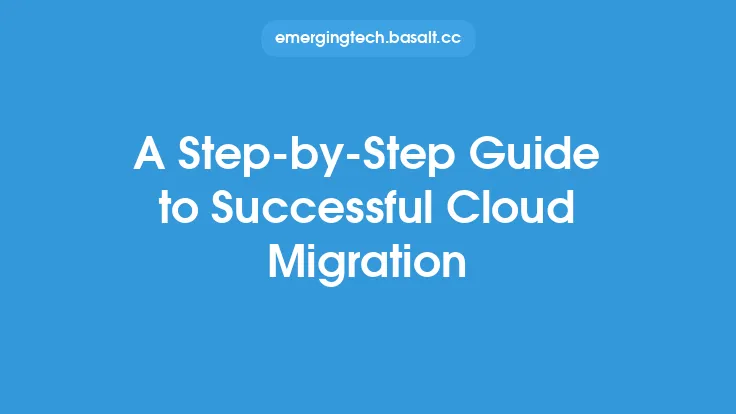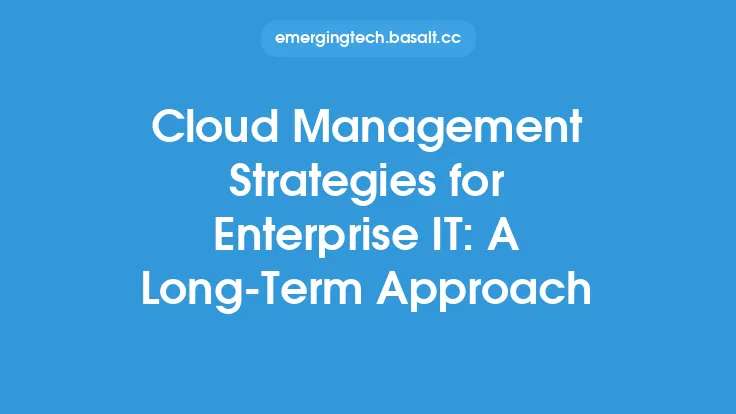Cloud management platforms are software solutions designed to manage and optimize cloud computing resources and services. These platforms provide a centralized interface for IT administrators to monitor, control, and automate various aspects of cloud infrastructure, applications, and data. With the increasing adoption of cloud computing, cloud management platforms have become essential tools for organizations to ensure efficient, secure, and cost-effective use of cloud resources.
Introduction to Cloud Management Platforms
Cloud management platforms are designed to address the complexities of cloud computing, which can include multiple cloud providers, diverse infrastructure, and a wide range of applications and services. These platforms provide a unified view of cloud resources, enabling IT administrators to manage and optimize cloud usage, performance, and security. Cloud management platforms typically support multiple cloud providers, including Amazon Web Services (AWS), Microsoft Azure, Google Cloud Platform (GCP), and IBM Cloud, among others.
Key Features of Cloud Management Platforms
Cloud management platforms offer a range of features that enable organizations to manage and optimize their cloud resources. Some of the key features include:
- Resource monitoring and management: Real-time monitoring of cloud resources, including compute, storage, and network resources.
- Cost management and optimization: Tracking and optimizing cloud costs, including resource utilization, reserved instances, and discounts.
- Security and compliance: Management of cloud security, including identity and access management, network security, and compliance with regulatory requirements.
- Automation and orchestration: Automation of cloud workflows, including provisioning, deployment, and scaling of resources.
- Application management: Management of cloud-based applications, including deployment, monitoring, and optimization.
- Data management: Management of cloud-based data, including storage, backup, and recovery.
Cloud Management Platform Architecture
Cloud management platforms typically consist of several components, including:
- Cloud connectors: Connectors that integrate with cloud providers' APIs to collect data and manage resources.
- Data analytics engine: An engine that analyzes data collected from cloud providers and provides insights into cloud usage and performance.
- Automation engine: An engine that automates cloud workflows and processes.
- User interface: A user-friendly interface that provides a centralized view of cloud resources and enables IT administrators to manage and optimize cloud usage.
- Integration with other tools: Integration with other IT tools, such as IT service management (ITSM) and configuration management database (CMDB) systems.
Benefits of Cloud Management Platforms
Cloud management platforms offer several benefits to organizations, including:
- Improved efficiency: Automation of cloud workflows and processes reduces manual errors and improves efficiency.
- Cost savings: Optimization of cloud costs and resource utilization reduces waste and saves money.
- Enhanced security: Management of cloud security and compliance reduces the risk of security breaches and non-compliance.
- Increased agility: Faster deployment and scaling of cloud resources enable organizations to respond quickly to changing business needs.
- Better decision-making: Insights into cloud usage and performance enable IT administrators to make informed decisions about cloud resources.
Choosing a Cloud Management Platform
Choosing a cloud management platform can be a complex task, as there are many vendors and products available in the market. When selecting a cloud management platform, organizations should consider the following factors:
- Cloud provider support: Support for multiple cloud providers, including the organization's preferred cloud providers.
- Feature set: A comprehensive set of features that meet the organization's cloud management needs.
- Scalability: Ability to scale with the organization's growing cloud needs.
- Integration: Integration with other IT tools and systems.
- Cost: Total cost of ownership, including licensing, support, and maintenance costs.
- Vendor reputation: Reputation of the vendor, including their experience, expertise, and customer support.
Implementing a Cloud Management Platform
Implementing a cloud management platform requires careful planning and execution. The following steps can help organizations implement a cloud management platform successfully:
- Assess cloud needs: Assess the organization's cloud needs, including cloud providers, resources, and applications.
- Choose a platform: Choose a cloud management platform that meets the organization's needs and requirements.
- Plan implementation: Plan the implementation, including setup, configuration, and testing.
- Deploy the platform: Deploy the platform, including installation, configuration, and integration with other IT tools.
- Train users: Train IT administrators and other users on the platform's features and functionality.
- Monitor and optimize: Monitor and optimize cloud usage and performance using the platform's analytics and automation capabilities.
Future of Cloud Management Platforms
The future of cloud management platforms is promising, with increasing demand for cloud management solutions. As cloud computing continues to evolve, cloud management platforms will need to adapt to new technologies and trends, such as:
- Artificial intelligence (AI) and machine learning (ML): Integration of AI and ML to provide predictive analytics and automation.
- Edge computing: Support for edge computing, including management of edge devices and applications.
- Serverless computing: Support for serverless computing, including management of serverless functions and applications.
- Hybrid and multi-cloud: Support for hybrid and multi-cloud environments, including management of multiple cloud providers and on-premises infrastructure.
- Security and compliance: Enhanced security and compliance features, including management of cloud security and compliance risks.





